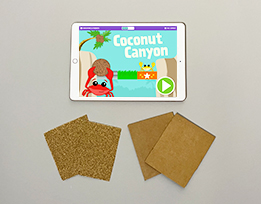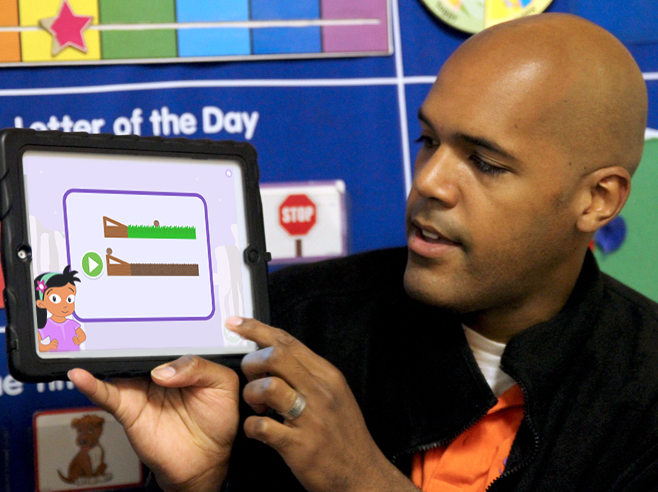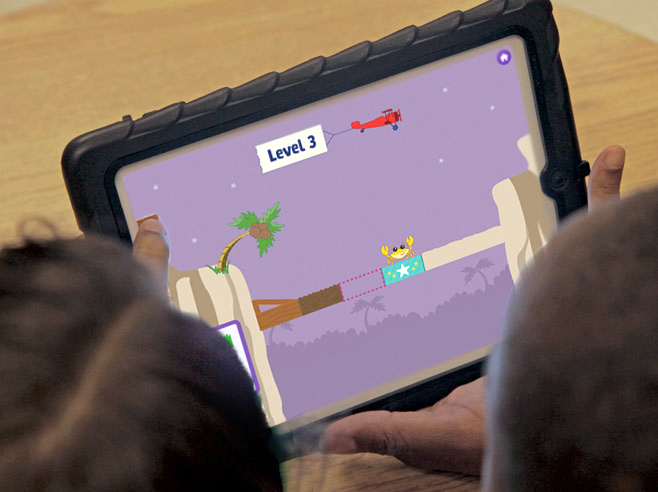Children try to make a coconut roll to a crab while exploring how the surface texture of the pathway affects how far the coconut will roll.
Materials

- Coconut Canyon digital game on iPads (1 device for Circle Time; several for Learning Centers)
- Optional: Projector (for Circle Time)
- 2–3 small sheets of sandpaper (about 6″ square)
- 2–3 small sheets of cardboard or posterboard (about 6″ square)
Preparation
- Familiarize yourself with the Coconut Canyon levels 1–12.
- If using a projector, set it up so you can display the iPad during Circle Time.
- Children are progressively challenged as they work through the 12 levels in the Coconut Canyon app: 1) different textures are added to the materials box, 2) the number of openings along the path that children fill with textured surfaces increases, and 3) the number of paths the coconut rolls along increases from one to two paths.
- Introduction: This section introduces the app and the three texture materials children will use throughout the app (grass, dirt, and metal).
- Levels 1–2. Introduce the bumpy grass texture. Observe how far a coconut moves on a bumpy surface. Children use grass to fill one opening on one to two paths.
- Levels 3–4. Children are introduced to a less bumpy surface texture: dirt. Observe how a coconut moves farther along a path that has a less bumpy surface. Children use grass and dirt to fill one opening on one to two paths.
- Levels 5–12. Children are introduced to a smooth surface texture: metal. Observe how a coconut moves the farthest distance along a path that has a smooth surface. Children use grass, dirt, and metal to fill one to four openings on one to two paths.
Directions: Lesson 10
Circle Time: Introduction
This game is introduced in a whole-group activity. Children will also explore the game independently at the Learning Center and review explorations during the Wrap-Up activities. To play, you can choose to tap the green play button to start from the beginning or tap the All Levels icon to go to a specific level.
Children explore how surface texture affects how an object moves along a path. In each level, they select the surface textures that will move the coconut to the crab. The in-game character, Nor, provides detailed instructions and feedback as children play.
- Introduction: Engage children in conversation about the texture of different materials. Invite them to share what they know about textures.
- Pass around the squares of sandpaper and cardboard. Invite children to feel the different textures. Possible discussion ideas:
- How does the sandpaper feel? How does the cardboard feel? Are they similar or different?
- Which one feels bumpy or rough? Which one feels smooth?
- Now explore some textures in the game. Tap the green play button to start exploring Coconut Canyon together. Listen to Nor’s introduction and watch the demonstration.
- Point out that the green dotted path shows how the coconut will travel on the path.
- Grass Introduction: Listen to Nor introduce the grass texture, and watch the demonstration.
- Notice that Nor describes the grass as bumpy. How would you describe how grass feels?
- Before hitting the play button, invite children to feel the sandpaper and cardboard pieces again. Which material feels bumpy to you?
- Have children make a prediction. Do you think the coconut will move far on the grass or not very far? Why? Let’s test it and find out!
- Invite a child to tap the round play button next to the ramp. Was your prediction correct? Why do you think it didn’t move very far? What did Nor tell us about grass: is it bumpy or smooth?
- Then have the child tap the green arrow button to continue.
- Levels 1–2. Point out the pink dotted outline on the path and tell children they will need to fill in this open section so the coconut can travel across the path and not fall through the opening.
- Invite a child to trace the path the coconut will travel from the tree to the crab. Discuss how far the coconut needs to travel to get to the crab.
- Next, draw children’s attention to the purple materials box on the left side of the screen.
- What texture do we have to use to finish building the path? (There is only grass.)
- Do you predict the coconut will move across the grass and get to the crab? Why or why not?
- You might want to replay the beginning of Level 1 to review how Nor drags the grass onto the path. If so, tap the purple home button in the right corner at the top of the screen. Then tap it again (green home button). On the opening screen, tap the All Levels button and choose Level 1.
- Notice how Nor drags the grass to the pink dotted opening on the path. Possible discussion ideas:
- What do you think will happen if we do not fill in the opening at all? Will the coconut make it to the crab? Let’s try it. Tap the “crab” button. What happened?
- Point out how the path opening fills with a pulsing yellow color if you still need to drag a material to fill in the opening.
- Explain to children that if they make an error a second time, a yellow outline will appear around a texture in the materials box. They should drag the outlined material over to the path and then tap the crab button to test their solution.
- Now ask a volunteer to drag the grass onto the path. Do you think the coconut will get to the crab? Let’s test our solution! Tap the crab button to test the solution.
- When a solution is successful, the crab will grab on to the coconut. Have the child tap the green arrow button to continue.
- In Level 2, children will notice there are two paths. What do you think will happen when the coconut lands on the little stars? Point out the ramp that is under the little stars.
- Notice how far the coconut needs to travel to get to the crab. Have a child drag the grass to the path. Do you think the coconut will make it to the crab? Let’s test it.
- What happened when the coconut went through the little stars? Elicit discussion about how it dropped and rolled down the lower ramp in the opposite direction.
- Tap the green arrow button to go to Level 3.
- Dirt Introduction: Listen to Nor introduce the less bumpy dirt texture, and watch the demonstration.
- Which surface texture looks less bumpy: the grass or the dirt?
- Do you predict the coconut will roll farther on the grass or on the dirt? Why? Let’s test it!
- Invite a child to tap the round play button next to the path. Was our prediction correct? On which texture did the coconut travel farther? Why do you think that happened? Then have the child tap the green arrow button to continue.
- Levels 3–4. Look at the path. Discuss how far the coconut has to travel to get to the crab.
- Point to the materials box and have children discuss the two different textures.
- On which texture do you think the coconut will move farther? Why do you think so?
- Have a child drag a texture from the materials box onto the path and then test it. Did the coconut go far enough? Too far? Why do you think that happened?
- Have children revise their solution if it did not work. Let’s test it again. How should we change the path? Why do you think this texture will work?
- After exploring the first levels with children, let them know that they will be able to continue to explore Coconut Canyon individually or with a partner in the Learning Center.
Learning Center
- Invite children to explore the Coconut Canyon game in pairs or individually. Observe how children approach each level of the game, and use prompts such as those used in previous Coconut Canyon activities to model for children and engage them in a discussion about texture.
- Invite children to feel the sandpaper and cardboard sheets and discuss how each texture feels. Then have them discuss how bumpy grass, less bumpy dirt, and smooth metal will affect how far the coconut moves on the Coconut Canyon path.
- Support children in thinking about cause and effect as they solve each challenge in the levels of Coconut Canyon. Have them discuss how they can test different surface textures to observe how far the coconut will roll along the path.
- Encourage children to listen to and build on each other’s ideas.
Directions: Lesson 11
Circle Time: Introduction
By adding a smooth surface texture (metal) to the materials box, the class can compare how the coconut moves on smooth vs. bumpy (grass and dirt) textured materials. They learn how objects move farther on smooth textures and less far on bumpy textures. In Level 5, Nor introduces the smooth metal texture.
- Metal Introduction: Invite children to listen and watch as Nor introduces a smooth texture: metal.
- Which surface texture looks smooth?
- Do you think the coconut will travel farther or less far on the metal than on the grass or dirt?
- On which surface texture do you predict the coconut will move the farthest? Why do you think so?
- Invite a volunteer to tap the round play button. Was your prediction correct? On which texture did the coconut travel farthest? Why do you think that happened? Have the child tap the arrow at the bottom of the screen to continue.
- Levels 5–12: As you go through the levels, encourage children to share ideas and contribute to one another’s ideas.
- Discuss the distance the coconut has to travel to reach the crab. Let’s look at how far the coconut needs to travel on the path to get to the crab. On which material do you think the coconut will travel that distance? Why do you think so? Have a child drag a material onto the path and then tap the crab button to test it.
- Why do you think the coconut did not move farther on the (grass/dirt/metal)?
- Which material do you predict will make the coconut move far enough to reach the small stars at the end of the path?
- What happens to the coconut when it reaches the small stars?
- How far does the coconut need to travel on the bottom path? On which material do you think the coconut will move that distance? Let’s test it out.
- Did your solution work? Do you need to choose another material? Let’s test it again.
- After investigating and discussing Circle Time explorations, encourage children to continue to explore and replay these levels in the Learning Center.
Guided Small Group
- Invite children to explore the Coconut Canyon game in pairs or individually. Observe how children approach each level of the game, and use prompts such as those used in previous Coconut Canyon activities to model for children and engage them in a discussion about texture.
- Invite children to feel the sandpaper and cardboard sheets and discuss how each texture feels. Then have them discuss how bumpy grass, less bumpy dirt, and smooth metal will affect how far the coconut moves on the Coconut Canyon path.
- Support children in thinking about cause and effect as they solve each challenge in the levels of Coconut Canyon. Have them discuss how they can test different surface textures to observe how far the coconut will roll along the path.
- Encourage children to listen to and build on each other’s ideas.
Circle Time: Wrap-Up
- Levels 5–12: Bumpy grass, less bumpy dirt, and smooth metal textures. Have individuals or pairs demonstrate using grass, dirt, or metal textures to complete the path and share how the coconut moved along the path. Encourage them to review and share their explorations from the Learning Center. Possible discussion ideas to use throughout the levels:
- What materials did you have available to build the path?
- Which texture did you predict would move the coconut to the crab? Why did you choose that texture?
- How would you describe the texture of the material?
- Did the coconut travel to the crab?
- Did your plan work? If not, why?
- Did you need to choose another material to fix the design? How did you change it?
- Encourage children to listen to, support, and build on each other’s ideas.
Directions: Lesson 12
Learning Center
- Invite children to explore the Coconut Canyon game in pairs or individually. Observe how children approach each level of the game, and use prompts such as those used in previous Coconut Canyon activities to model for children and engage them in a discussion about texture.
- Invite children to feel the sandpaper and cardboard sheets and discuss how each texture feels. Then have them discuss how bumpy grass, less bumpy dirt, and smooth metal will affect how far the coconut moves on the Coconut Canyon path.
- Support children in thinking about cause and effect as they solve each challenge in the levels of Coconut Canyon. Have them discuss how they can test different surface textures to observe how far the coconut will roll along the path.
- Encourage children to listen to and build on each other’s ideas.
Circle Time: Wrap-Up
- Levels 5–12: Bumpy grass, less bumpy dirt, and smooth metal textures. Continue to have children review and share their explorations from Whole Group and Learning Center activities.
- Possible discussion ideas to use throughout the levels:
- What materials did you have available to build the path?
- How would you describe the texture of the material?
- Did your plan work? If not, why?
- Did you need to choose another material to fix the design? How did you change it?
- What is one new thing you learned about how objects move on different textures?
- Name an object in the classroom that is (bumpy/smooth).
- Encourage children to listen to, support, and build on each other’s ideas.


